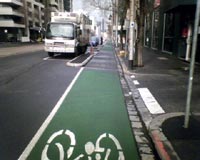 Our streets are part of the lifeblood of our communities, and how they are designed, and who they are designed for, matters more than we might realize. “Incomplete” streets are often inaccessible by foot, bicycle, or public transportation, or even if they do provide accommodations for these modes of transportation, they might be unpleasant and attractive and do little to encourage these modes.
Our streets are part of the lifeblood of our communities, and how they are designed, and who they are designed for, matters more than we might realize. “Incomplete” streets are often inaccessible by foot, bicycle, or public transportation, or even if they do provide accommodations for these modes of transportation, they might be unpleasant and attractive and do little to encourage these modes.
Earlier this month, the Victoria Transport Policy Institute released Evaluating Complete Streets: The Value of Designing Roads For Diverse Modes, Users and Activities. The report discusses differences between conventional transport planning and Complete Streets planning, especially relating to costs and benefits. According to the report, the main cost of Complete Streets is a reduction in arterial traffic speeds, and sometimes the reduction of “the number of traffic and parking lanes, but by providing center turn lanes, smoothing traffic flow and encouraging mode shifts, they often carry as many people as previously.” The report finds that in communities that desire alternative modes of transportation and more compact development, complete streets can provide real benefits, including improved accessibility, emissions reductions, and energy savings. Check it out here:http://www.vtpi.org/compstr.pdf
The heavy reliance on driving has an impact far beyond today’s traffic jam. People who are less likely to own cars and more likely to rely on public transportation are particularly affected by poor development patterns. Working families who own a car are burdened with associated expenses: purchase cost, maintenance, registration fees, fuel, and others.
Streets designed solely for automobile travel also put people at risk. In 2007, there were 4,654 pedestrian deaths and 70,000 reported pedestrian injuries –- that’s nearly one every eight minutes. In a poll of people over 50 years old, 47 percent said it was unsafe to cross the street near their home. In neighborhoods where traffic is a nuisance and a threat, residents both young and old are more inclined to stay in their homes. This limits much needed physical activity and social interaction.
Complete streets foster livable communities
Complete streets are roadways that are designed with all users – bikers, walkers, transit riders and drivers – in mind. Roads are built to safely accommodate a variety of transportation modes and users of all ages and abilities. Complete Streets are planned, designed and constructed to blend with the local community while meeting transportation needs.Communities are increasingly embracing smart growth to meet their residents’ desire for choices in housing, shopping, recreation, and transportation. Complete streets meet the demand for transportation options, while promoting other community goals. They provide safe and affordable access for everyone, whether traveling to school, work, the doctor, or their favorite restaurant.
More than half of Americans recently surveyed would like to walk more and drive less. Poor community design and lack of pedestrian facilities are the primary reasons people cite for not walking more. An overwhelming number support policies intended to make their communities more livable by reducing traffic speed and creating a safer pedestrian environment.
In their Complete Streets Policy, the NJ Department of Transportation recognized these benefits of complete streets:
- Complete Streets improve safety for pedestrians, bicyclists, children, older citizens, non-drivers and the mobility challenged as well as those that cannot afford a car or choose to live car free
- Provide connections to bicycling and walking trip generators such as employment, education, residential, recreation, retail centers and public facilities
- Promote healthy lifestyles
- Create more livable communities
- Reduce traffic congestion and reliance on carbon fuels thereby reducing greenhouse gas emissions
- Complete Streets make fiscal sense by incorporating sidewalks, bike lanes, safe crossings and transit amenities into the initial design of a project, thus sparing the expense of retrofits later
A full list of the current counties and municipalities in New Jersey who have adopted Complete Streets policies can be found here. Is your community on the list? If not, would you like it to be? GMTMA can help your community “complete the streets.” We can facilitate informational presentations, provide templates for policy resolutions and assist in drafting policy resolutions, help create an implementation plan, assist with identification of grant funding and documentation of policy for Sustainable Jersey certification, and more. Contact us today!
